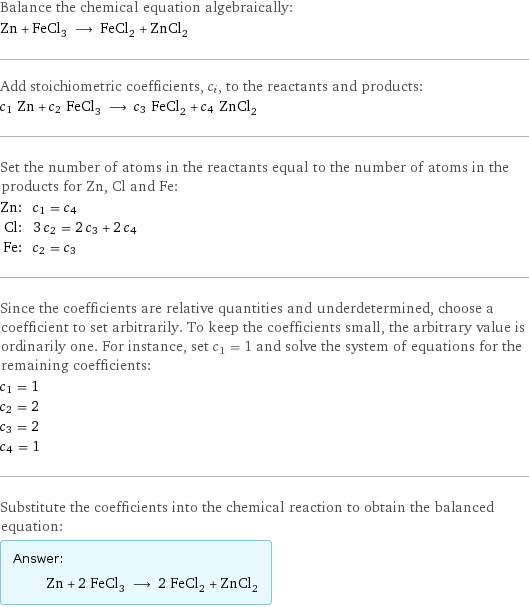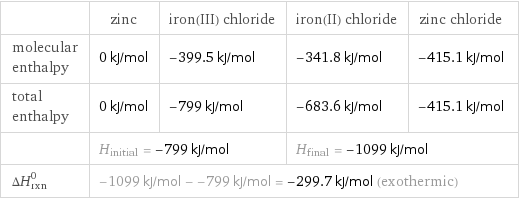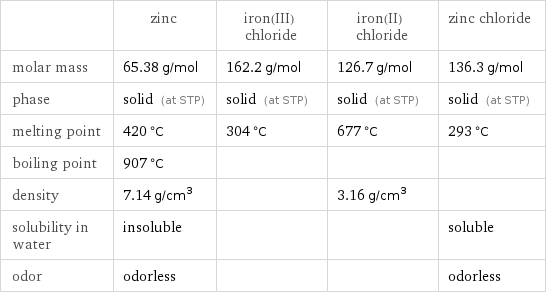Input interpretation

Zn zinc + FeCl_3 iron(III) chloride ⟶ FeCl_2 iron(II) chloride + ZnCl_2 zinc chloride
Balanced equation

Balance the chemical equation algebraically: Zn + FeCl_3 ⟶ FeCl_2 + ZnCl_2 Add stoichiometric coefficients, c_i, to the reactants and products: c_1 Zn + c_2 FeCl_3 ⟶ c_3 FeCl_2 + c_4 ZnCl_2 Set the number of atoms in the reactants equal to the number of atoms in the products for Zn, Cl and Fe: Zn: | c_1 = c_4 Cl: | 3 c_2 = 2 c_3 + 2 c_4 Fe: | c_2 = c_3 Since the coefficients are relative quantities and underdetermined, choose a coefficient to set arbitrarily. To keep the coefficients small, the arbitrary value is ordinarily one. For instance, set c_1 = 1 and solve the system of equations for the remaining coefficients: c_1 = 1 c_2 = 2 c_3 = 2 c_4 = 1 Substitute the coefficients into the chemical reaction to obtain the balanced equation: Answer: | | Zn + 2 FeCl_3 ⟶ 2 FeCl_2 + ZnCl_2
Structures

+ ⟶ +
Names

zinc + iron(III) chloride ⟶ iron(II) chloride + zinc chloride
Reaction thermodynamics
Enthalpy

| zinc | iron(III) chloride | iron(II) chloride | zinc chloride molecular enthalpy | 0 kJ/mol | -399.5 kJ/mol | -341.8 kJ/mol | -415.1 kJ/mol total enthalpy | 0 kJ/mol | -799 kJ/mol | -683.6 kJ/mol | -415.1 kJ/mol | H_initial = -799 kJ/mol | | H_final = -1099 kJ/mol | ΔH_rxn^0 | -1099 kJ/mol - -799 kJ/mol = -299.7 kJ/mol (exothermic) | | |
Equilibrium constant
![Construct the equilibrium constant, K, expression for: Zn + FeCl_3 ⟶ FeCl_2 + ZnCl_2 Plan: • Balance the chemical equation. • Determine the stoichiometric numbers. • Assemble the activity expression for each chemical species. • Use the activity expressions to build the equilibrium constant expression. Write the balanced chemical equation: Zn + 2 FeCl_3 ⟶ 2 FeCl_2 + ZnCl_2 Assign stoichiometric numbers, ν_i, using the stoichiometric coefficients, c_i, from the balanced chemical equation in the following manner: ν_i = -c_i for reactants and ν_i = c_i for products: chemical species | c_i | ν_i Zn | 1 | -1 FeCl_3 | 2 | -2 FeCl_2 | 2 | 2 ZnCl_2 | 1 | 1 Assemble the activity expressions accounting for the state of matter and ν_i: chemical species | c_i | ν_i | activity expression Zn | 1 | -1 | ([Zn])^(-1) FeCl_3 | 2 | -2 | ([FeCl3])^(-2) FeCl_2 | 2 | 2 | ([FeCl2])^2 ZnCl_2 | 1 | 1 | [ZnCl2] The equilibrium constant symbol in the concentration basis is: K_c Mulitply the activity expressions to arrive at the K_c expression: Answer: | | K_c = ([Zn])^(-1) ([FeCl3])^(-2) ([FeCl2])^2 [ZnCl2] = (([FeCl2])^2 [ZnCl2])/([Zn] ([FeCl3])^2)](../image_source/ab6c2e89a7726ca8f2aa8495a60f4a63.png)
Construct the equilibrium constant, K, expression for: Zn + FeCl_3 ⟶ FeCl_2 + ZnCl_2 Plan: • Balance the chemical equation. • Determine the stoichiometric numbers. • Assemble the activity expression for each chemical species. • Use the activity expressions to build the equilibrium constant expression. Write the balanced chemical equation: Zn + 2 FeCl_3 ⟶ 2 FeCl_2 + ZnCl_2 Assign stoichiometric numbers, ν_i, using the stoichiometric coefficients, c_i, from the balanced chemical equation in the following manner: ν_i = -c_i for reactants and ν_i = c_i for products: chemical species | c_i | ν_i Zn | 1 | -1 FeCl_3 | 2 | -2 FeCl_2 | 2 | 2 ZnCl_2 | 1 | 1 Assemble the activity expressions accounting for the state of matter and ν_i: chemical species | c_i | ν_i | activity expression Zn | 1 | -1 | ([Zn])^(-1) FeCl_3 | 2 | -2 | ([FeCl3])^(-2) FeCl_2 | 2 | 2 | ([FeCl2])^2 ZnCl_2 | 1 | 1 | [ZnCl2] The equilibrium constant symbol in the concentration basis is: K_c Mulitply the activity expressions to arrive at the K_c expression: Answer: | | K_c = ([Zn])^(-1) ([FeCl3])^(-2) ([FeCl2])^2 [ZnCl2] = (([FeCl2])^2 [ZnCl2])/([Zn] ([FeCl3])^2)
Rate of reaction
![Construct the rate of reaction expression for: Zn + FeCl_3 ⟶ FeCl_2 + ZnCl_2 Plan: • Balance the chemical equation. • Determine the stoichiometric numbers. • Assemble the rate term for each chemical species. • Write the rate of reaction expression. Write the balanced chemical equation: Zn + 2 FeCl_3 ⟶ 2 FeCl_2 + ZnCl_2 Assign stoichiometric numbers, ν_i, using the stoichiometric coefficients, c_i, from the balanced chemical equation in the following manner: ν_i = -c_i for reactants and ν_i = c_i for products: chemical species | c_i | ν_i Zn | 1 | -1 FeCl_3 | 2 | -2 FeCl_2 | 2 | 2 ZnCl_2 | 1 | 1 The rate term for each chemical species, B_i, is 1/ν_i(Δ[B_i])/(Δt) where [B_i] is the amount concentration and t is time: chemical species | c_i | ν_i | rate term Zn | 1 | -1 | -(Δ[Zn])/(Δt) FeCl_3 | 2 | -2 | -1/2 (Δ[FeCl3])/(Δt) FeCl_2 | 2 | 2 | 1/2 (Δ[FeCl2])/(Δt) ZnCl_2 | 1 | 1 | (Δ[ZnCl2])/(Δt) (for infinitesimal rate of change, replace Δ with d) Set the rate terms equal to each other to arrive at the rate expression: Answer: | | rate = -(Δ[Zn])/(Δt) = -1/2 (Δ[FeCl3])/(Δt) = 1/2 (Δ[FeCl2])/(Δt) = (Δ[ZnCl2])/(Δt) (assuming constant volume and no accumulation of intermediates or side products)](../image_source/c06bfd784b0a8d9310c3b7599c4d34bf.png)
Construct the rate of reaction expression for: Zn + FeCl_3 ⟶ FeCl_2 + ZnCl_2 Plan: • Balance the chemical equation. • Determine the stoichiometric numbers. • Assemble the rate term for each chemical species. • Write the rate of reaction expression. Write the balanced chemical equation: Zn + 2 FeCl_3 ⟶ 2 FeCl_2 + ZnCl_2 Assign stoichiometric numbers, ν_i, using the stoichiometric coefficients, c_i, from the balanced chemical equation in the following manner: ν_i = -c_i for reactants and ν_i = c_i for products: chemical species | c_i | ν_i Zn | 1 | -1 FeCl_3 | 2 | -2 FeCl_2 | 2 | 2 ZnCl_2 | 1 | 1 The rate term for each chemical species, B_i, is 1/ν_i(Δ[B_i])/(Δt) where [B_i] is the amount concentration and t is time: chemical species | c_i | ν_i | rate term Zn | 1 | -1 | -(Δ[Zn])/(Δt) FeCl_3 | 2 | -2 | -1/2 (Δ[FeCl3])/(Δt) FeCl_2 | 2 | 2 | 1/2 (Δ[FeCl2])/(Δt) ZnCl_2 | 1 | 1 | (Δ[ZnCl2])/(Δt) (for infinitesimal rate of change, replace Δ with d) Set the rate terms equal to each other to arrive at the rate expression: Answer: | | rate = -(Δ[Zn])/(Δt) = -1/2 (Δ[FeCl3])/(Δt) = 1/2 (Δ[FeCl2])/(Δt) = (Δ[ZnCl2])/(Δt) (assuming constant volume and no accumulation of intermediates or side products)
Chemical names and formulas

| zinc | iron(III) chloride | iron(II) chloride | zinc chloride formula | Zn | FeCl_3 | FeCl_2 | ZnCl_2 Hill formula | Zn | Cl_3Fe | Cl_2Fe | Cl_2Zn name | zinc | iron(III) chloride | iron(II) chloride | zinc chloride IUPAC name | zinc | trichloroiron | dichloroiron | zinc dichloride
Substance properties

| zinc | iron(III) chloride | iron(II) chloride | zinc chloride molar mass | 65.38 g/mol | 162.2 g/mol | 126.7 g/mol | 136.3 g/mol phase | solid (at STP) | solid (at STP) | solid (at STP) | solid (at STP) melting point | 420 °C | 304 °C | 677 °C | 293 °C boiling point | 907 °C | | | density | 7.14 g/cm^3 | | 3.16 g/cm^3 | solubility in water | insoluble | | | soluble odor | odorless | | | odorless
Units
